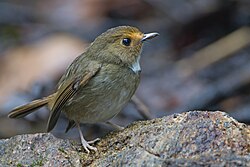| Anthipes | |
|---|---|
 | |
| Rufous-browed flycatcher (Anthipes solitaris) | |
| Scientific classification | |
| Kingdom: | Animalia |
| Phylum: | Chordata |
| Class: | Aves |
| Order: | Passeriformes |
| Family: | Muscicapidae |
| Genus: | Anthipes Blyth, 1847 |
| Type species | |
| Dimorpha monileger [1] Hodgson, 1845 | |
The Anthipes flycatchers are a genus of Old World flycatchers.
The genus contains the following species: [2]
- White-gorgeted flycatcher, Anthipes monileger
- Rufous-browed flycatcher, Anthipes solitaris